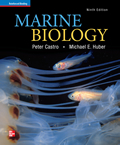1 A) True B) False 2 A) Bathypelagic, abyssopelagic, hadal B) Mesopelagic, epipelagic, abyssopelagic C) Abyssopelagic, hadal, Bathypelagic, D) Epipelagic, mesopelagic, bathypelagic 3 A) True B) False 4 Nautilus achieves neutral buoyancy by which of these mechanisms?A) Removing ions from chambers in its shell. B) Moving lipids between chambers in its shell. C) Jet propulsion. D) A thin, light shell. 5 A) Cnidarians, chaetognaths, crustaceans, fishes, and squids. B) Diatoms, copepods, chaetognaths, and fishes. C) Copepods, cephalopods, foraminiferans, and large fishes. D) Medusae, ctenophores, copepods, and squids. 6 A) A chaetognath B) A squid with photophores C) A hagfish D) The larval stage of a barnacle 7 A) True B) False 8 A) It migrates vertically. B) It must be an active swimmer. C) It eats detritus. D) It is a sit-and-wait predator. 9 A) Large changes in temperature. B) Anoxic water below the thermocline. C) High primary productivity at depth. D) No light at all. 10 A) Lack of ambient light. B) The energy requirements to be bioluminescent. C) Eutrophication of mid-depth waters. D) Limited food availability 11 A) Exoskeletons of shrimp. B) Bones in fishes. C) gas-filled swim bladders. D) Shells of pteropods. 12 A) Mate attraction B) Confusing predators C) Orienting the organism to the surface during vertical migration D) Luring prey 13 A) Horseshoe crabs B) Ostracods C) Flounder D) Tube worms 14 A) Speed B) Spines and scales C) Camouflage D) Chemical defenses 15 A) True B) False 16 A) True B) False 17 A) Color patterns. B) Light patterns from rows of photophores. C) A powerful sense of smell. D) Touch. 18 A) Light levels B) Pressure. C) Salinity changes. D) Oxygen 19 A) Anoxic Layer B) Hadopelagic Layer C) Oxygen Minimum Zone/Layer D) Eutrophication Layer 20 A) Parasites B) Hermaphrodites C) Epiphytes D) Epifauna 21 A) Neumatocysts. B) Ink sacs. C) Photophores. D) Chromatophores. 22 A) Shorter B) The same as C) Longer D) Their life-spans cannot be calculated. 23 A) Sea cucumbers. B) Sea spiders. C) Sponges. D) Ostracods. 24 A) A small, thin fish with large teeth and rows of photophores B) A shrimp carrying several hundred small eggs C) A suspension-feeding clam D) A scavenging amphipod with an expandable gut 25 A) countershading B) Maneuverability C) Vertical migration D) Enriched hemoglobin 26 A) Mangrove swamp B) Coral Reef C) Tropical rainforest D) The deep ocean floor 27 A) Iron-sulfide B) Calcium-carbonate C) Hydrogen-sulfide D) Methane-hydrate 28 A) Tube worms and ostracods B) Anglerfish and phytoplankton C) Archaea and bacteria D) Sea spiders and nautilus 29 A) Phytoplankton. B) Cyanobacteria. C) Chemosynthetic archaea. D) Decomposing bacteria. 30 A) Green B) Orange C) Blue D) Red





